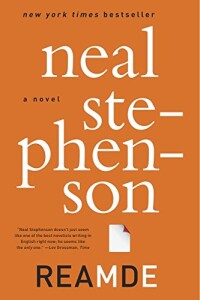 I’ve liked everything I’ve read by Seattle speculative fiction writer Neal Stepehson, starting with Snow Crash and The Diamond Age but haven’t kept up with him since 2010’s Anathem. With a new book out in 2019 that is apparently a sequel to 2011’s Reamde, I thought I’d better catch up.
I’ve liked everything I’ve read by Seattle speculative fiction writer Neal Stepehson, starting with Snow Crash and The Diamond Age but haven’t kept up with him since 2010’s Anathem. With a new book out in 2019 that is apparently a sequel to 2011’s Reamde, I thought I’d better catch up.
Reamde is an action thriller with elements of what used to be called cyberpunk and the spy novel, based on real events in the realm of cybersecurity that were just beginnning to happen in 2011. Specifically ransomware, in which hackers take over your computer’s files by encrypting them, and requiring you to pay to get the decryption code. It’s got about a dozen main characters who are thrown together in far-flung locations by the ramifications of this ransomware plot, with action that keeps leaping off the book’s 1,100 pages so fast that it was hard to put it down.
The gist of the plot is: Chinese hackers have set up a ransomware scheme that requires its victims to pay the ransom from within a huge international multi-player swords-and-dragons online game called T’Rain (pronounced “terrain”). One of their victims is a Russian mobster who was playing fast and loose with his syndicate’s money and now needs to get it back and who also wants revenge on the hackers. His mad quest for vengeance sweeps up most of the book’s other characters, and also accidentally rubs up against an al Qaeda-like terrorist cell that’s planning some kind of major action.
Most of the story takes place in and around the Pacific Northwest and the Chinese port city of Xiamen, with a certain amount of action within the T’Rain game itself, and some James Bond-like zipping about in corporate jets and on boats both fast and slow. The chief protagonists are Richard Forthrast, an Iowa native who’s lived in Seattle for many years now, founder and owner of the company that owns T’Rain (i.e., an internet billionaire) and Zula Forthrast, his college-age niece, adopted into the family as a child, an orphaned Eritrean refugee. The supporting cast includes Zula’s boyfriend Peter; Ivanov, the Russian mobster and Sokolov, his chief “security consultant”; Csongor, a Hungarian hacker who’s been working for Ivanov; the chief of the Chinese hacker gang in Xiamen who goes by “Marlon”; Yuxia, a spunky young Chinese tea merchant and street hustler; Olivia Halifax-Lin, a member of MI-6; Seamus, who’s in some nebulous arm of U.S. military security; and Abdallah Jones, a Brit of West Indian ancestry, head of the jihadists.
The book is a bit slow to start, as we’re introduced to Richard, also known by his teenage nickname of Dodge, and his extended family, and the background and workings of T’Rain and the Seattle-based corporation that owns it. The opening scenes take place at the Forthrast family homestead in rural Iowa at the annual family reunion, which features a lot of target shooting by young and old as a way of establishing early on the family’s familiarity with firearms – which will come in handy later. The scene then quickly shifts to Dodge’s corporate ski lodge in southern British Columbia, where Peter’s enigmatic encounter with a shady Scottish character sets the stage for all the action to come.
As I said, I found the book difficult to put down once the action got rolling. It was the first time in quite a while that I’d read such a big book that got me so involved, and it was a welcome change from the usual absorption with screens and social media. Stephenson is a straightforward writer with a good ear for dialogue and a good hand at action scenes. He engineers the story so plausibly that I willingly suspended my disbelief at the way all the surviving major characters came together for the climax. He doesn’t lard his prose with adjectives or similes, and he injects a good deal of wit into the proceedings. Here he gets to toss in a lot of inside humor about the Pacific Northwest, its coffee, beer, cars, weather and mildew, all of which I appreciated. He also does his research into topics like firearms and the history and current state of China’s economy, and it shows in the easy flow of the story’s details but is never trotted out in mountains of verbiage designed to impress the gullible. The only thing I raised my eyebrow at was the deus ex machina-like appearance of a wild creature in the mountains where the final scenes take place. A minor quibble in an otherwise excellent yarn.
So if you’re looking for a big ol’ book to entertain you at the beach or better yet in the mountains this summer, consider Reamde. As for me, I’m highly anticipating the follow-up.
(2011, William Morrow)
